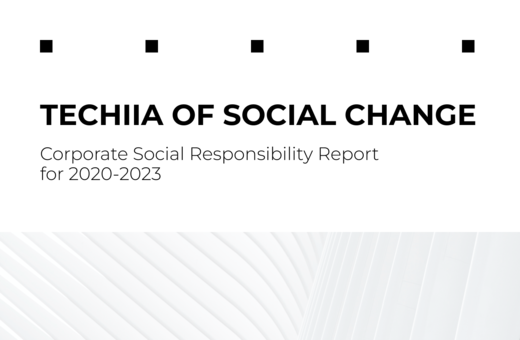
In his column for Forbes, Yura Lazebnikov, managing partner of the international holding TECHIIA, talks about the impact of the latest technologies on the construction industry, and why it is worth investing in their development.
The invention of cofferdams revolutionized the field of bridge construction, tower cranes led to the emergence of skyscrapers, and self-supporting glass units technology allows for the construction of large glass facades without a metal frame. It seems that humanity has already learned to build any kind of object. However, the industry is not standing still: new technologies appear almost every year, which allow building in an even faster, more complex, and safer way.
Carefully following construction trends, I would divide them into three categories:
- digitization of the industry — the use of software solutions by construction companies for scaling;
- inventing new and improving existing building materials and structures;
- using new technology and devices such as heavy drones or augmented reality glasses.
Here are the ways I’m seeing these technologies impact the construction industry and why leaders in this space should take note of these trends.
Go Digitizing
"You can't rush greatness" are the words I heard about implementing large projects from builders. For example, the Great Pyramid of Giza, the largest structure of the ancient world, took 27 years to build. Or the world's tallest skyscraper, Burj Khalifa, which took almost six years to construct.
One could assume that people simply haven't learned to build complex structures quickly. But that's not the case. Building quickly can be done with a clear plan. However, many developers have big problems with planning and budget allocation.
According to , implementing large-scale construction projects usually takes 20% more time than planned, and construction costs exceed the budget by 80%. Take the same Burj Khalifa. Due to inefficient planning, the tower opened nine months later than planned, the budget by almost double.
The main reason for such problems is paper reporting. In fact, today, it is perhaps the most significant factor that hinders the development of the industry, which is .
The good news is that this problem can be solved by integrating Building Information Modeling (BIM) technology into the construction sector. Cloud services like Autodesk BIM 360, Navisworks, ArchiCAD, or Revit allow potential errors to be identified even at the project creation stage, thereby the project's realization time by 50%, unplanned changes during construction by 40% and budget by 52%.
These indicators are achieved through effective communication among all contractors, which can finally occur in the cloud in real-time. The second factor is exceptional transparency: a detailed 3D model provides a detailed description of the work and technologies, helping to accurately estimate the amount of materials and workers.
The downside of BIM is the high cost, which is why many developers use free but highly inefficient planning methods.
Green materials
One of the main trends is using eco-friendly materials, such as hemp, used to make construction blocks. The mixture of hemp stalks with binding materials is called . This material is twice as light as regular concrete, more energy-efficient, and at the same time just as strong.
More exotic, in my opinion, is . As the mushroom grows, it creates a biomaterial that is used to make insulation panels, construction blocks, and even scale wood, tiles, and furniture. Panels made from mushrooms have very high thermal and sound insulation properties.
Another innovative material is a combination of clay with hydrogel. Such has a cooling effect, which is relevant for warm countries where savings on room cooling could be achieved.
Many are experimenting with concrete, one of the most widely used materials in the world, but is not very plastic, cracks over time, and is too susceptible to moisture. One solution to these problems is to combine concrete with graphene. Graphene concrete has very high strength and does not allow moisture to pass through. For example, conventional gas concrete walls used in rapid construction can be replaced with ready-made blocks consisting of ceramic granite tiles with thermal insulation materials glued between them.
Finally, there is glass. Here, innovation is mainly in the approach. For example, one of the companies of our holding has developed a technology for frameless glazing. It is based on a special insulated glass unit that does not require frames or supports. This changes the very principle of glazing and, in addition to a number of bonuses, allows for the elimination of unnecessary and not very eco-friendly aluminum from the building.
Autonomous machinery and wearable technologies
Inventing a fundamentally new machine for digging holes or carrying loads is difficult, so manufacturers are focusing on improving existing ones. They are switching them from traditional fuel to electricity, such as the 20-ton Komatsu , and teaching them to perform tasks , without human involvement.
Young segments are actively developing, such as the market for 3D printers in construction, which at a rate of 69% per year. However, this figure could be even higher: technology development is constrained by current construction standards.
Another segment is wearable technologies. This includes augmented reality that allow a person on a construction site to obtain information about the location and properties of objects, warnings about hazards, or just directions.
Wearable technologies are typically referred to as smart. Smart helmets, for example, parameters to calculate workers' fatigue levels. Smart shoes staff movement on the construction site and warn of hazardous areas or potential collisions with construction machinery. They can also generate energy while in motion — two hours of walking around the site can provide an hour of smartphone use.
Finally, I will say that the world is changing so rapidly that new technologies in the construction market will not be long in coming. The next big thing in this field is likely to be related to planetary surface construction. Perhaps this will happen before the first flight to Mars, for 2037. It is interesting to think about whether it will be possible to build mushroom houses on other planets.

